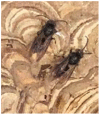Behaviour of Vespa velutina nigrithorax (Hymenoptera: Vespidae) under Controlled Environmental Conditions
- PMID: 36661987
- PMCID: PMC9864241
- DOI: 10.3390/insects14010059
Behaviour of Vespa velutina nigrithorax (Hymenoptera: Vespidae) under Controlled Environmental Conditions
Abstract
From its introduction in Europe, Vespa velutina nigrithorax has become an invasive species, since it is a predator of native fruits and insects, most of the latter being honeybees. Despite the knowledge on the life cycle of this hornet, Asian hornet behaviour is not well understood, since in vivo studies on this species are quite difficult to perform. In this work, an observational study of the behaviour of this invasive species in captivity has been carried out. Two secondary and one embryo nests were caught and kept under controlled environmental conditions, up to 13 weeks for the secondary nest and 6 weeks for the embryo nest. Captivity adaptation, defence against perturbations, evolution of the colony and overwintering were the different behaviours studied. The study has shown the importance of avoiding disturbances to the nest from the beginning of the experiments, since they tend to destroy the colony. The aggressive behaviour observed in the embryo nest was lower than in the secondary nests. Results of this research will allow obtaining additional information on this species, which is crucial to develop effective control methods.
Keywords: Vespa velutina nigrithorax; behavioural study; embryo and secondary nest.
Conflict of interest statement
The authors declare no conflict of interest. The funders had no role in the design of the study; in the collection, analyses, or interpretation of data; in the writing of the manuscript; or in the decision to publish the results.
Figures













References
-
- Hochberg M.E., Gotelli N.J. An Invasions Special Issue. TREE. 2005;20:211. doi: 10.1016/j.tree.2005.03.005. - DOI
-
- Couto A., Monceau K., Bonnard O., Thiéry D., Sandoz J. Olfactory Attraction of the Hornet Vespa velutina to Honeybee Colony Odors and Pheromones. [(accessed on 15 April 2021)];PLoS ONE. 2014 9:e115943. doi: 10.1371/journal.pone.0115943. Available online: https://www.ncbi.nlm.nih.gov/pubmed/25549358. - DOI - PMC - PubMed
-
- López S., González M., Goldarazena A. Vespa velutina Lepeletier, 1836 (Hymenoptera: Vespidae): First records in Iberian Peninsula. [(accessed on 15 April 2021)];Bull. OEPP. 2011 41:439–441. doi: 10.1111/j.1365-2338.2011.02513.x. Available online: https://api.istex.fr/ark:/67375/WNG-3NXV2C7F-6/fulltext.pdf. - DOI
-
- Bunker S. The Asian Hornet Handbook. Psocid Press; Mountain View, CA, USA: 2019.
-
- Martin S. The Asian Hornet (Vespa velutina) Threats, Biology & Expansion. Northern Bee Books; Mytholmroyd, UK: 2017.
Grants and funding
LinkOut - more resources
Full Text Sources

